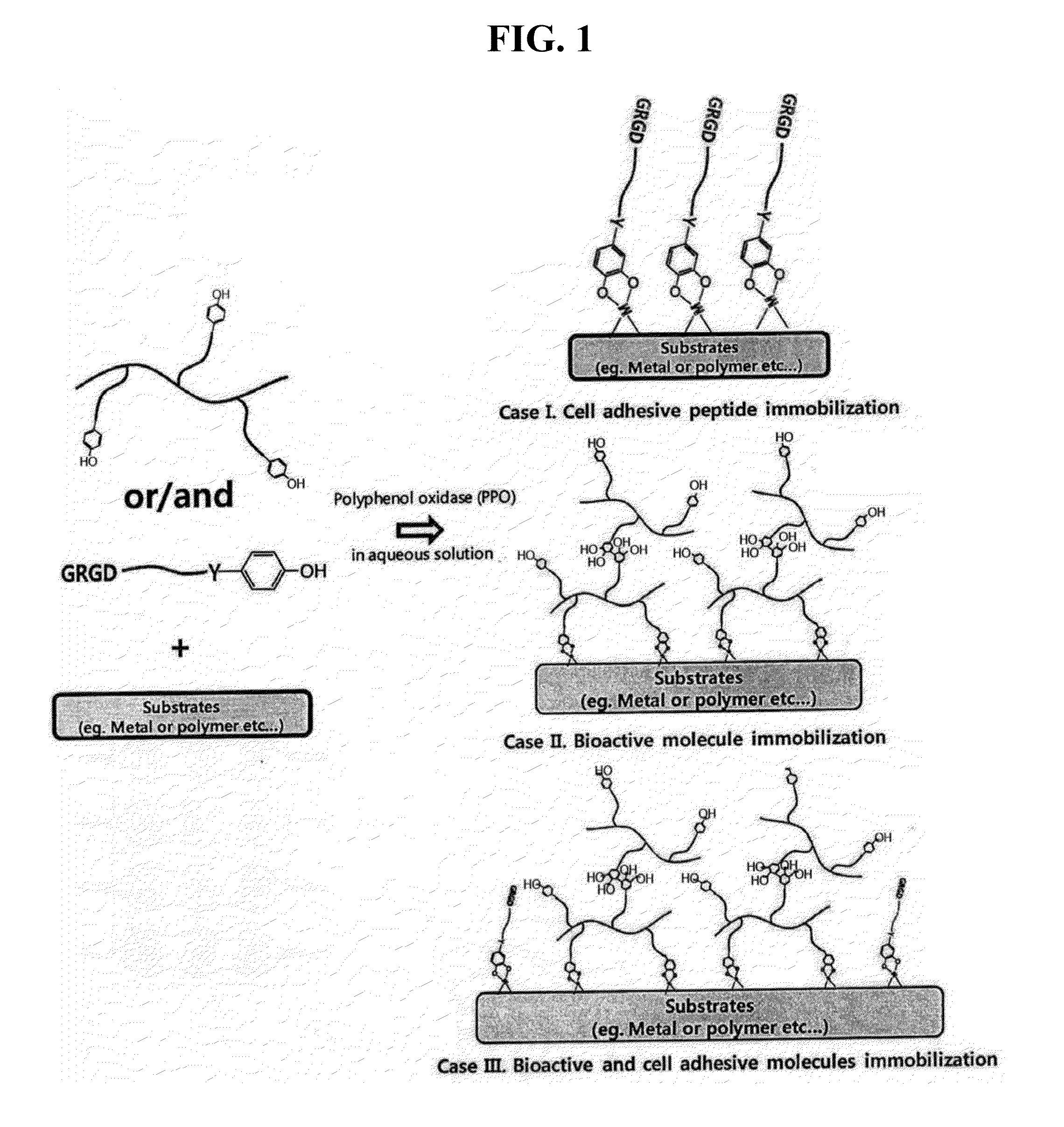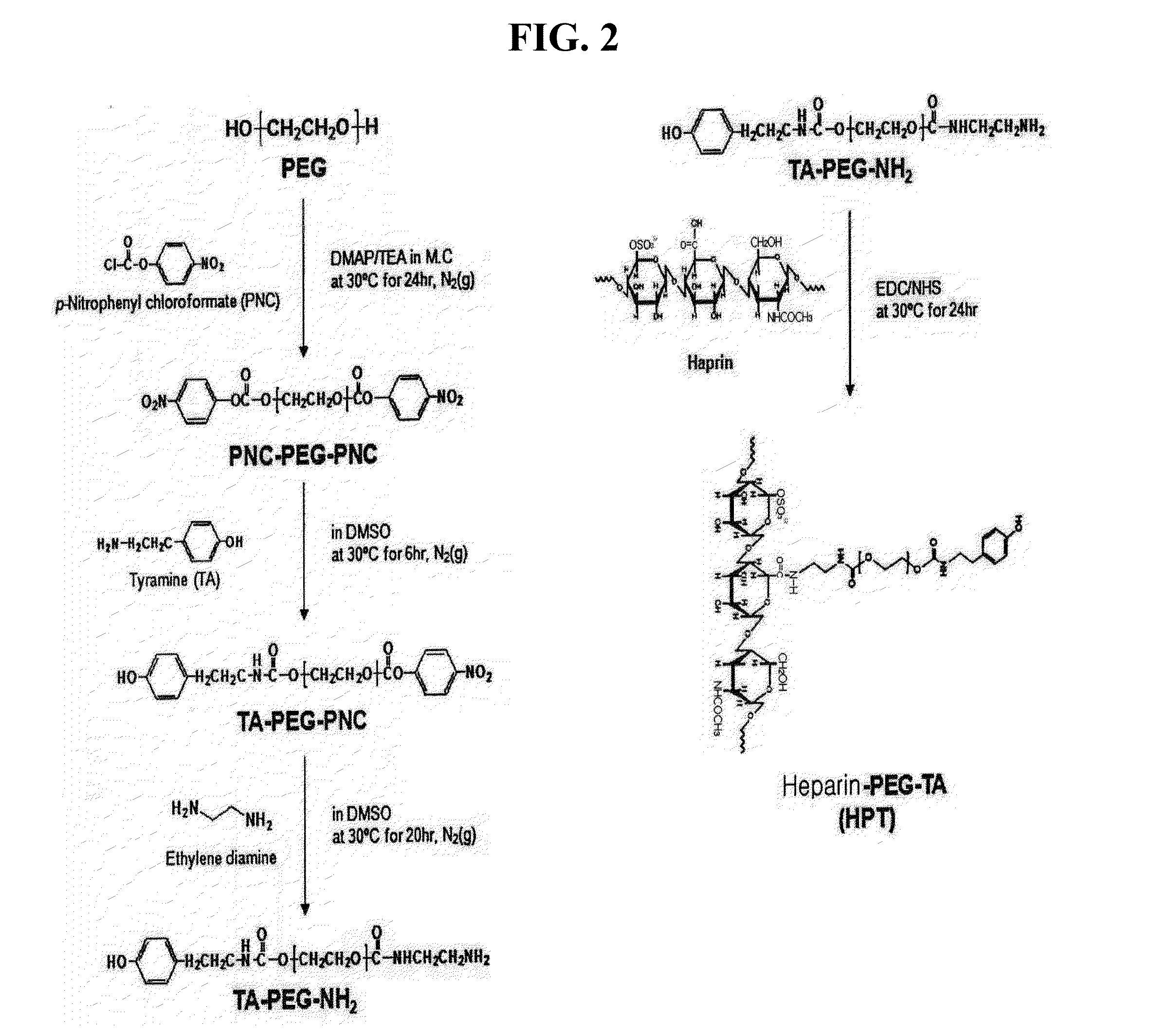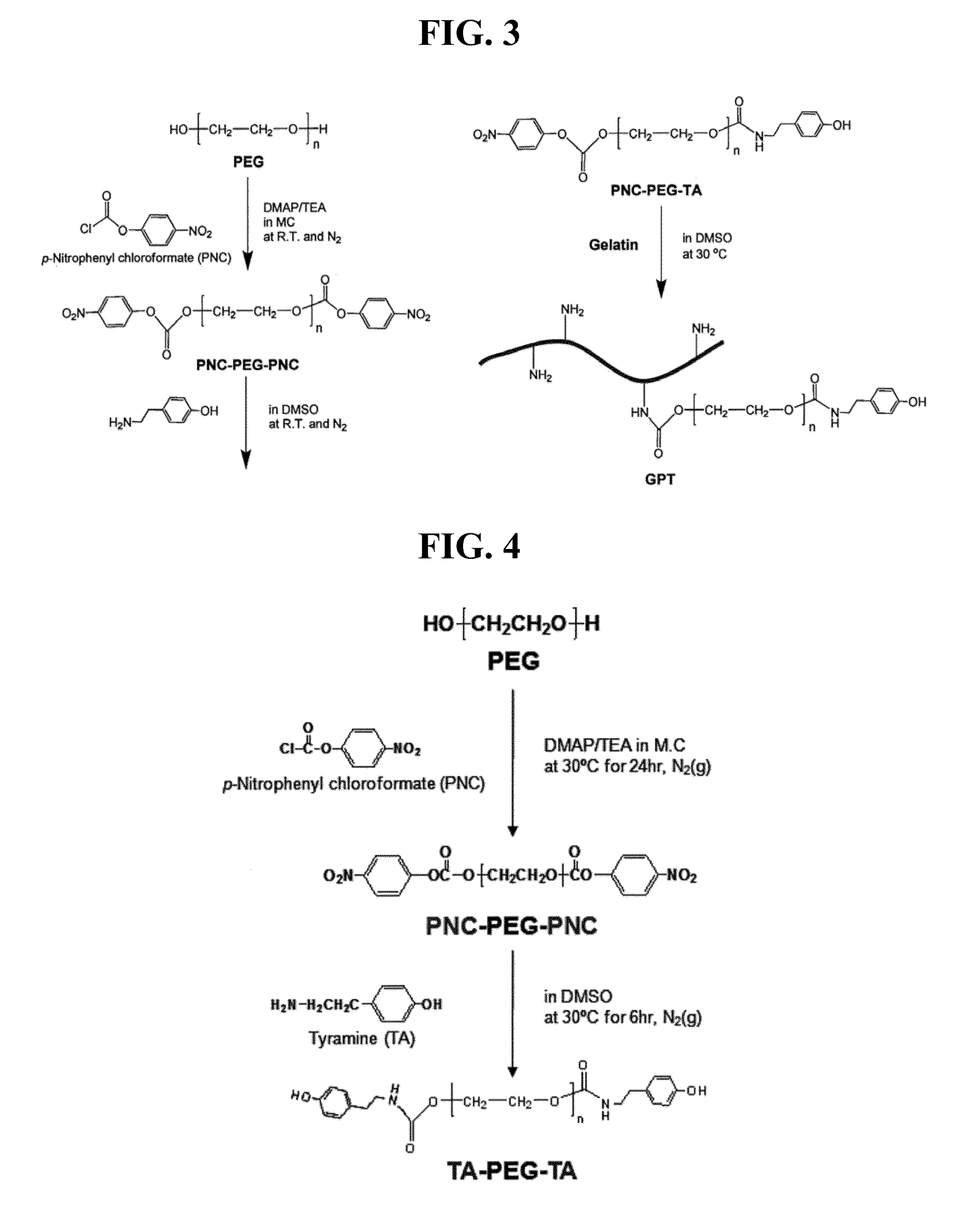Immobilization method of bioactive molecules using polyphenol oxidase
- Summary
- Abstract
- Description
- Claims
- Application Information
AI Technical Summary
Benefits of technology
Problems solved by technology
Method used
Image
Examples
synthesis example 1
Synthesis of Heparin-Poly(ethylene glycol)-Tyramine (HPT)
[0105]The synthesis of HPT is schematically illustrated in FIG. 2.
1. Synthesis of poly(ethylene glycol)-(p-nitrophenylchloroformate) [PEG-PNC]
[0106]A solution of 10 g (2.9 mmol) of PEG in 100 mL of MC was mixed sequentially with a solution of 0.779 g (6.38 mmol) of 4-dimethylaminopyridine (DMAP) and 0.645 g (6.38 mmol) of triethylamine (TEA) in 10 mL of MC and a solution of 1.286 g (6.38 mmol) of PNC in 50 mL of MC, with the molar ratio of PEG:DMAP:TEA:PNC being 1:2.2:2.2:2.2. A reaction was performed at 30° C. for 24 hrs in a nitrogen atmosphere.
[0107]After completion of the reaction, reagents which remained unreacted were removed by filtering the reaction mixture. This filtrate was then concentrated using a rotary evaporator. The concentrate was dropwise added to 1600 mL of chilled ether to form precipitates which were then obtained by filtration. The filtrate was allowed to stand for 24 hrs in a vacuum oven to remove the re...
synthesis example 2
Synthesis of Gelatin-Poly(ethylene glycol)-Tyramine (GPT)
[0112]FIG. 3 is a reaction scheme showing the synthesis of GPT.
[0113]1. PEG-PNC Synthesis
[0114]To a solution of 10 g (2.9 mmol) of PEG in 100 mL of MC were added a solution of 0.779 g (6.38 mmol) of 4-dimethylaminopyridine (DMAP) and 0.645 g (6.38 mmol) of triethylamine (TEA) in 10 mL of MC and a solution of 1.286 g (6.38 mmol) of PNC in 50 mL of MC in the order, with the molar ratio of PEG:DMAP:TEA:PNC being 1:2.2:2.2:2.2. A reaction was performed at 30° C. for 24 hrs in a nitrogen atmosphere.
[0115]After completion of the reaction, the reaction mixture was filtered to remove the remaining reagents and then concentrated using a rotary evaporator. The concentrate was dropwise added to 1600 mL of chilled ether to form precipitates, which were then obtained by filtration. The filtrate was allowed to stand for 24 hrs in a vacuum oven to remove the remaining organic solvents to afford the desired compound (PEG-PNC) as a white powde...
synthesis example 3
Synthesis of Tyramine-Poly(ethylene glycol)-Tyramine(PEG-TA)
[0119]FIG. 4 is a reaction scheme showing the synthesis of a tyramine-poly(ethylene glycol)-tyramine(PEG-TA) copolymer.
[0120]1. Synthesis of PEG-PNC
[0121]To a solution of 10 g (2.9 mmol) of PEG in 100 mL of MC were added a solution of 0.779 g (6.38 mmol) of 4-dimethylaminopyridine (DMAP) and 0.645 g (6.38 mmol) of triethylamine (TEA) in 10 mL of MC and a solution of 1.286 g (6.38 mmol) of PNC in 50 mL of MC in the order, with the molar ratio of PEG:DMAP:TEA:PNC being 1:2.2:2.2:2.2. A reaction was performed at 30° C. for 24 hrs in a nitrogen atmosphere.
[0122]2. Synthesis of tyramine-poly(ethylene glycol)-tyramine (PEG-TA)
[0123]To a solution of 5 g (1.25 mmol) of PEG-PNC in 100 mL of methylene chloride (MC) was added 0.383 g (2.75 mmol) of tyramine (TA) in 100 mL of MC, with the molar ratio of PEG-PNC:TA being 1:2.2. A reaction was conducted at 30° C. for 6 hrs in a nitrogen atmosphere.
[0124]After completion of the reaction, ...
PUM
| Property | Measurement | Unit |
|---|---|---|
| Time | aaaaa | aaaaa |
| Time | aaaaa | aaaaa |
| Concentration | aaaaa | aaaaa |
Abstract
Description
Claims
Application Information
 Login to View More
Login to View More - R&D
- Intellectual Property
- Life Sciences
- Materials
- Tech Scout
- Unparalleled Data Quality
- Higher Quality Content
- 60% Fewer Hallucinations
Browse by: Latest US Patents, China's latest patents, Technical Efficacy Thesaurus, Application Domain, Technology Topic, Popular Technical Reports.
© 2025 PatSnap. All rights reserved.Legal|Privacy policy|Modern Slavery Act Transparency Statement|Sitemap|About US| Contact US: help@patsnap.com



